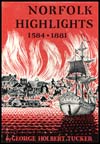Chapter 18
The Ball in the Wall
If there is any doubt that the cannonball imbedded in the walls of Norfolk's historic St. Paul's Church is authentic, the following article should end it permanently. Signed "Native," the article appeared Sunday, August 1, 1875, in The Norfolk Virginian. Headed "The Cannon Ball in Old St. Paul's," the piece has this to say:
"About the year 1848, the writer of this piece, then a pupil at Mr. William R. Galt's school, held in the old Academy, Church Street, opposite St. Paul's Church, remembers seeing the old cannon ball immediately after it was found.
"It seems that the ball, fired from the British fleet, January 1, 1776, and which lodged in the south side of the the head of the cross (the old church being constructed in the shape of a Latin cross), remained there for many years until, during the time the building was unused and the graveyard neglected, it fell from its position and was forgotten.
"Some years later the church was reopened by the present congregation, the building repaired and the cemetary put in order.
"About 1848 the assertion was made that the ball had fallen from its place unnoticed and was probably imbedded in the earth in the angle formed by the church and the street wall, and to test its correctness, the late Capt. F.W. Seabury, a vestryman of the church, got Mr. Wm. W. Lamb (also a vestryman) to send his servant with a spade to the churchyard.
"Under the direction of Capt. Seabury, the servant found the ball immediately under where it had first lodged in the wall, about 18 inches below the surface of the earth.
"The rusty old ball was seen soon after its resurrection by the writer, and was the identical one fired by the British frigate Liverpool into the venerable edifice.
"The same ball is now fastened in the wall with plaster, in the place it first struck when fired."
So much for serious history. Now for two yarns concerning the cannonball from the anecdotal quiver of Armistead Bayne, former director of Norfolk's MacArthur Memorial and a former staff member of the Norfolk Redevelopment and Housing Authority. Bayne gleaned the two stories while acting as host to celebrities visiting the city.
This is how Bayne told them to James S. Walmsley, whose column, "At Large," was a popular feature in Commonwealth, The Magazine of Virginia.
"When Lord Louis Mountbatten visited Norfolk as First Lord of the Admiralty and one of NATO's chieftans, a group of Navy brass took him to see the cannonball. With some relish they pointed out that one of Lord Dunmore's warships fired the ball when the Royal governor was destroying Norfolk in one of the British Navy's less majestic episodes.
"After explaining what had happened, the Americans stood back and waited, perhaps with inward smirks, for the British sea dog's reaction. There was a long pause.
"'Hahnnh,' Mountbatten snorted, gazing cooly at the projectile bulging from the near corner of the wall. 'Damn near missed it, didn't he?'"
Bayne's other cannonball yarn goes this way.
"Norfolk, as almost everyone knows, is a wonder of urban renewal. It is naturally proud of its achievement and often plays host to visiting urban renewal experts from other cities. One such group was being taken on a bus tour of the downtown with a Norfolk-trained urban renewal expert at the microphone explaining things. Glibly he rattled off a prodigious quantity of information without muffing a line or fact and then, with pride in the city's past, he pointed at the old church as they approached it and cried, 'And up on that wall, gentlemen, is a cannonball fired by Cornwall Jackson!'"
Chapter
19
The Dunmore Ball
Norfolk Highlights 1584 - 1881

See the "Table of Contents" for links to every chapter in Norfolk Highlights 1584 - 1881 by George Holbert Tucker.
